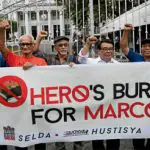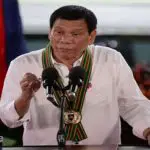According to the rules of the Armed Forces of the Philippines, AFP Regulations G 161-375, a deceased personnel may be disqualified from being buried at the Libingang ng mga Bayani if that person had dishonorable discharge from the army or is convicted by final judgement “for an offense involving moral turpitude.”
These conditions might be the rule that will hinder late dictator Ferdinand Marcos from being buried at the Libingan ng mga Bayani.
“Moral turpitude, it has been said, includes everything which is done contrary to justice, honesty, modesty, or good morals,” this was defined by Justice George A. Malcolm using Bouvier’s Law Dictionary in 1920 when he decided on what seemed to be the very first decision involving this issue.
“The inherent nature of the act is such that it is against good morals and the accepted rule of right conduct,” Malcolm added.
Recently, the Supreme Court has three approaches in determining whether the case involves moral turpitude (Brion concurring in Teves v. Comelec, G.R. No. 1803363, April 28, 2009).
First is to determine whether “the act itself must be inherently immoral; second, “to look at the act committed through its elements as a crime”; and third, “essentially takes the offender and his acts into account in light of the attendant circumstances of the crime: was he motivated by ill will indicating depravity?”
Now the question is, why does this apply to late president Marcos?
On October 22, 1940, 76 years ago, Marcos was convicted for an offense that may be judged as involving moral turpitude. Young Ferdinand Marcos, along with three of his relatives, were found guilty of contempt because of filing eight different complaints against the principal witness for the murder of Julio Nalundasan, even before the trial arrived to a conclusion.
[ads1]
Julio Nalundasan, the rival of Ferdinand’s father, congressman Mariano Marcos, was killed by a sniper’s bullet on the night of September 20, 1935 days after he defeated Mariano in the congressional elections.
Mariano Marcos was charged with murder along with his brother Pio, their brother-in-law Quirino Lizardo, and Ferdinand, who was then an 18-year-old student of the University of the Philippines and was, by various accounts, a sharpshooter.
The case was passed on to the Supreme Court (G.R. No. L-47388, People of the Philippines v. Mariano Marcos et al.) that the Marcoses and Lizardo filed eight separate complaints against the principal witness, Calixto Aguinaldo. The four involved in the murder case accused Aguinaldo of making false testimonies against them in the preliminary investigation on December 7, 1938.
However, it was determined that the eight complaints were filed even before the trial of the three Marcoses had begun and only Lizardo’s trial had commenced. In court, there has to be a final judgement first before any charge of false testimony can be filed against a witness.
According to the Supreme Court, “it is evident that the charges for false testimony filed by the four accused above mentioned could not be decided until the main case for murder was disposed of, since no penalty could be meted out to Calixto Aguinaldo for his alleged false testimony without first knowing the extent of the sentence to be imposed against Lizardo and the Marcoses (Revised Penal Code, art. 180).”
While Marcos and Lizardo were acquitted of their murder charge, the three Marcoses and Lizardo were found guilty of desacato (contempt), according to Justice Jose Laurel. They were ordered to pay a fine of P200, or in case of insolvency or non-payment, the corresponding jail time by the Court of First Instance but Laurel’s decision lowered the fine to P50. The conviction, however, stayed.
Since Ferdinand Marcos was found guilty, the first element in the AFP provision for disqualifications is met.
[ads2]
While it was indicated in the final decision of the High Court on the Nalundasan case that the contempt committed by the Marcoses was indirect and civil in nature, it also stated in the decision that the action done by the Marcoses and Lizardo were “directly or indirectly obstructing the administration of justice,” which could mean they committed “a duly forbidden act.”
Presently, there is no jurisprudence in the Philippines which states that obstruction of justice involves moral turpitude, the action of the Marcoses and Lizardo was meant to harass the main witness through legal action.
This piece by UP Diliman Third World Studies Center researchers Miguel Paolo P. Reyes and Joel F. Ariate Jr. was published by ABS-CBN on November 16.
Source: (news.abs-cbn.com)
[ads3]


